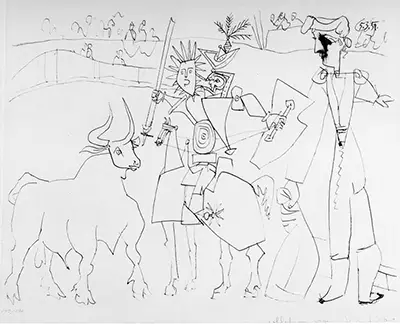From a young age, Pablo accompanies his father to watch bullfights. As a little boy, he was mightily fascinated by the theatrical brutality and animal instincts which emanates from such brutal fights. As he grew up, he continued to avidly follow ferias and bullfights in the arenas of Spain (Malaga) and France (Vallauris, Nimes, Arles, etc). In fact, his passion for picadors and bullfighting was so intense that he said that he would have been a picador had he not been a painter!
Picador on the horseback on arena is, no doubt, one of the most popular paintings by Picasso. Dating back to 1951, this painting is done in surrealism style, featuring horses, bulls, picadors and bull fighters. In the background a huge throng can be seen witnessing the fierce sport. Picasso ventured into surrealism and neoclassicism styles of painting during the period of 1919 to 1929. Prior to that he practiced African art and primitivism, synthetic cubism and analytic cubism.
Although Picasso is known for using colors in order to express himself in paintings, Picador on the horseback on arena has none and yet it manages to tell such an intriguing story! Picasso was known to be a night owl and he used to paint late at night with artificial light illuminating his canvas. The Picador on the horseback on arena painting is said to have been created at night too. While this painting focused on the subject of bullfighting, Picasso didn’t necessarily limit himself to a specific number of themes or subjects, he had a remarkable stylistic versatility and was able to do justice to a wide number of styles at once, be it the female form, landscapes, cubism paintings, objects or animals.
Picasso was extraordinarily prolific throughout his career. He is said to have produced around 50,000 artworks throughout his lifetime, which includes drawings, paintings, sculptures, ceramics, prints and so on.


